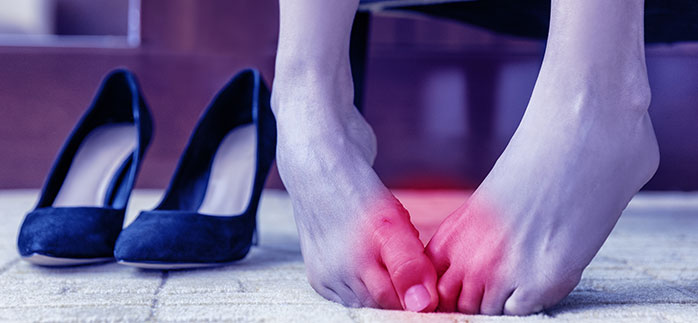That painful bony bump on the side of your big toe? It’s probably a bunion. Nearly a quarter of people age 18-65 have bunions, making them one of the most common foot issues among adults. They also run in families and are more prevalent among women (thanks, cute heels), and among those over 65. In fact, more than a third of people over age 65 (36 percent) have bunions.
Whether it runs in your family or you’ve been choosing fashion over function, there are five key things you should know to deal with your bunion and move past the pain.
What causes bunion pain?
We know what predisposes people to getting bunions, but what’s happening with our feet to cause so much pain? It starts when your big toe begins to turn in toward your second toe. As that happens, the joint at base of the big toe bone pushes out to the side, where it meets your footbone (called the first metatarsal) and that pressure causes pain. This area carries a great deal of weight when you are standing or walking, and that pressure causes pain. The area may become red and callused over time. The pain can become so severe that it’s difficult to wear shoes.
Bunions range from mild to severe and should be treated differently
Depending on how prominent and painful your bunion is, your orthopedic or podiatric surgeonmay recommend a variety of treatments that can slow the progression of your bunion, or minimize the pain, but surgery is the only way to truly correct the situation. Beware of ‘treatments’ claiming non-surgical bunion removal.
Popular methods to manage bunion pain and slow progression are wearing supportive well-fitting shoes that align your foot properly for walking, using orthotics or a gel pad to cushion the area when wearing shoes and wearing a splint at night.
There are a variety of available orthotics (or orthoses) including over-the-counter or off-the-shelf commercial products and, as necessary, custom-molded orthotics that are generally prescribed medical devices.
Bunion surgery may be needed
Moderate or severe bunions and can involve cutting the joint at the big toe and then aligning it properly. In more severe cases, the entire joint may be replaced with metal plates and screws. See a video animation of how surgery corrects the bunion.
Don’t ignore bunion pain
If you let a bunion become too severe, you are likely to run out of non-surgical options for pain relief and may even need to consider a more involved surgical procedure such as replacing a joint in your toe or fusing bones together. This equates to a longer and more complex recovery time, not to mention prolonging your pain unnecessarily by not seeing a doctor and making a treatment plan. If you’ve had pain for a year or more, it’s definitely time to see a doctor to review your options.
Recovery takes time
The most common kind of bunion surgery is on an out-patient basis and takes around two months to recover. Your doctor will work with you to create a recovery plan which may include a special boot, rest, stretching and/or physical therapy. Active adults who want to return to load bearing exercise like running and jumping may need longer to get back in the action – but that’s time well spent if they can return to their activities bunion and pain free.
Learn more about your bunion treatment options with one of our podiatric surgeons:










